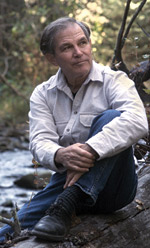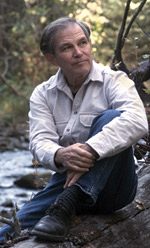“I had to get other people to pay for ninety percent of the acreage. To be sure they didn?t ruin my Walden with their suburbia, I wrote covenants.”
“Like all of humankind, the people who welcomed my covenants often found that their ideals changed or their particular circumstance convinced them to break the rules. Usually community pressure has resolved the problems.”
I wrote my first environmental covenants because I wanted to make other people pay to preserve the green shade, the clear stream, and the wildlife in 330 acres of piedmont North Carolina forest. That was thirty-two years ago when I was a young English professor. I thought making people do the right thing was the proper business of government, but the government did not love the piece of land I had found fourteen miles south of the University of North Carolina at Chapel Hill.
No one wanted to save this forest but me.
Since it was little more than a typical second-growth oak and hickory forest patched with squares of pine, why did I want it? Dirt farmers had gladly left it for the mills and other factories in the ?30s and ?40s. I had come to love it when I walked along the cold clear ribbon of Brooks Branch and watched a sucker run, and when I had discovered by an old wagon road a smaller stream and along it a patch of old-growth beech and hickory forest. I loved it because it had been abandoned and was restoring itself.
I intended to build a small house and live like Henry David Thoreau by a small creek two miles back from the public road. I could not afford to buy and preserve the land with my own money. I had to get other people to pay for ninety percent of the acreage. To be sure they didn?t ruin my Walden with their suburbia, I wrote restrictive covenants. In my sales ads I called them environmental covenants.
Under American law, a landowner selling property can write rules to shape the use of that property almost to the end of eternity. Yes, there is a rule against perpetuities or locking people into some condition that might be unreasonable in light of future events. This is easily accommodated by giving landowners the right to assemble after 25 or 30 years to consider if they want to continue their mutual covenants or bury and forget them, as I, their original author, will have been long buried and forgotten.
I did not restrict house size or design, only requiring that the proper buffers separate neighbors from seeing each other. We had a foam dome, a tipi, a neo-Victorian mansion, an elegant Japanese solar home, remodeled tobacco barns, A-frames, old farm houses, and mobile homes. Our buyers included blacks and whites, hippies and retired military men, gays and lesbians, blue collar workers and heirs of fortunes.
Although my idea received a lot of publicity as being novel, only the subject?trees, water, and wildlife protection?differed from traditional real estate practices and legal principle. My first set of covenants, which seemed avant-garde to so many people, were actually quite simple. The most novel conditions were these:
- Chlorinated hydrocarbon pesticides were prohibited;
- Each tract had to maintain a 50-foot border of undisturbed woodlands and set the houses back 75 feet from any border;
- Hoofed animals could not be grazed along streambeds;
- Minimum lot size was five acres;
- No more than 50% of any homestead could be cleared.
Soon after the first Earth Day, I sold 300 acres and kept the remaining thirty for my private Walden. I was proud that unlike Thoreau, who rejected land ownership and proposed public ownership to preserve token wild places, I had done it privately, and I could stay a lot longer than the two years and two months Thoreau stayed on the land he borrowed from Ralph Waldo Emerson.
For better or worse, the financial success of my development brought me more opportunities to try new versions, each repairing the holes and flaws in previous versions and tailored to the special character of the land they restricted. For a 110-acre tract split by a major highway I wrote covenants that allowed for craft stores on the highway frontage, but with restrictions on appearance, sign size, and lighting. On a historic plantation I helped the owner write covenants to protect the integrity of old buildings and fields. On a riverside property, I set aside an acre for public canoe access.
On occasion I also burdened buyers with impossible ideals. I had put together a group of investors who liked my way of preserving land for a profit, and we agreed that we should sell the land as cheaply as possible. This led me to write a covenant to prevent buyers from simply reselling and prevent buyers from simply reselling and gathering the extra profit we had forgone. The covenant said that the sale price could be no more than the original price of the land plus the construction cost of any house on it, both adjusted by the rise in the Consumer Price Index. Any excess was to go into a trust fund to help low-income buyers.
As resales began a few years later, lawyers searching titles would call me in shocked disbelief. And landowners, whether socialists, anarchists, or libertarians, and despite the fact that they had understood and agreed to the covenants, wanted full market value. After a few nightmarish sales, they met and unanimously removed this covenant.
The environmental covenant that has caused the most trouble was a ban on hunting. On large tracts of land, deer herds have multiplied into marauding packs and squirrels strip fruit and nut trees, while raccoons specialize in raiding sweet corn. And, like all of humankind, the people who welcomed my covenants often found that their ideals changed or their particular circumstance convinced them to break the rules. Usually community pressure, including the threat of legal action, has resolved the problem.
My last development, some 700 acres of forest along the Haw River, began in the late 1980s and was sold out by 1995. It has my best informed set of covenants. After a statement of purpose, explaining the goals clearly so that any court will understand the reasons for the covenants, the provisions include the following, among others:
- No night light may stay on all night, be automatically triggered by dusk, or shine onto a neighbor?s land or into the border buffers;
- Conservation easements along the borders of lots provide both wildlife corridors and community walking and hiking in undisturbed land, while leaving even dead trees undisturbed;
- Dogs and cats have to be kept on an owner?s property;
- Bug zappers are prohibited;
- Electronic amplification of sound is prohibited;
- Houses must be built with structural termite prevention to minimize the use of persistent pesticides.
All the residential developments with these environmental covenants sold out nicely. None of the projects rewarded investors with less than a 12% annualized return, while most bested the 15% more typical of land development projects.
Restrictive covenants came into American law from ancient traditions. They do not entirely eliminate threats from outside powers, especially the arbitrary exercise of the power of government. But they give to the ordinary private landowner the powers that kings and queens once had?except that no one had to be the subject of my ideas and whims. Living at Walden Pond is one of many forms of the American dream, and the freedom to enter into those contracts called covenants is the way to make the dream a lasting reality.
In addition to preserving real estate, Wallace Kaufman is the author of several books, including Coming Out of the Woods (Perseus Publishing). Most of the covenants the author has applied to land projects are recorded and available in the courthouses of Orange and Chatham counties, North Carolina.




